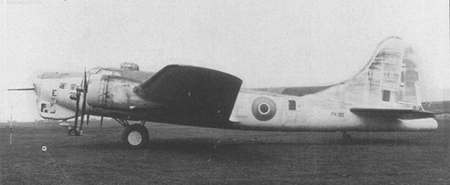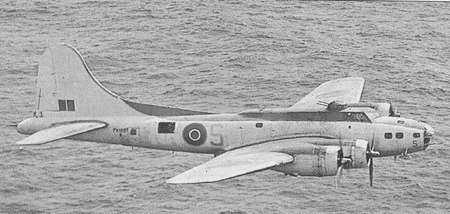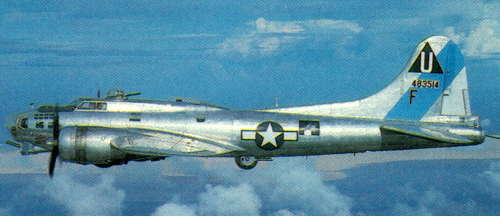Development
Boeing's model 299, a four-engined aircraft designed as a long-range patrol bomber, made its first flight on 28 July 1935. It had been a bold initiative to offer a four-engined aircraft to the USAAC (US Army Air Corps) as a replacement for the Martin B-10. Boeing had the advantage that it could use experience gained with the design of the B-15, a prototype long-range bomber, but even so it had considerable difficulty to finance the project. The performance of the 299 seemed to justify all hopes, because it outperformed its competitors by a substantial margin. Unfortunately it crashed on 30 October, on an official demonstration flight. Although the aircraft was not to blame, Boeing was eliminated from the competition. The less advanced, but cheaper Douglas B-18 was ordered to meet the original requirement.
But the aircraft was certainly impressive, and the press gave it the name Flying Fortress. Officers within the USAAC were also favourably impressed, and Boeing received an order for thirteen Y1B-17 aircraft, with Wright Cyclone instead of Pratt & Whitney Hornet engines. Twelve of them were given to the 2nd Bombardment Group. This unit not only pioneered high-altitude and long-distance bombing, but also made a number of well-published demonstration flights. This kept the B-17 in the spotlight, but that did have disadvantages. At that time the strong isolationist feelings in the USA did not tolerate the concept of a strategic bombing campaign. Instead, the bombers were advocated to protect the coast of the continental USA and its possession in the Pacific against enemy fleets. Of course this was a source of rivalry between the USAAC and the US Navy, and the B-17 was one of the most important pawns in this battle. In May 1938 eight B-17s "intercepted" the Italian liner Rex, 800 miles out into the sea, but after the dispute that followed the USAAC was restricted to flights within 100 miles off the coast.
One airframe was converted to the Y1B-17A, with turbosupercharged engines, that gave it much better high-altitude performance. The next model, the B-17B, was the first production aircraft with turbosupercharged engines. After a dispute with the Navy, the USAAC was allowed to buy only 39 B-17Bs. Later, the outbreak of war in Europe and the starting rearmament of the USA resulted in orders for 39 B-17Cs and 42 B-17Ds. These models included armour, self-sealing fuel tanks, and improved defensive armament. In early 1941 the RAF received 20 B-17Cs. The USAAC was reluctant to part with so many of its scarce bombers, but on the other hand this was an opportunity to test the type in combat. High-altitude operations over Europe revealed many flaws, and soon the surviving aircraft -- called Fortress Mk.I by the RAF -- were transferred to Coastal Command. Of the remaining B-17s, many were lost after the Japanese attack in December 1941.

The original model 299 had been armed with five manually aimed, .30 machineguns: One in the nose, and one each in dorsal, ventral, and two waist blisters. The later models had seen some modifications, but the armament had remained essentially similar. Modern air combat called for more guns, preferably installed in powered gun turrets, with suitable gunsights for high-speed combat instead of the primitive ring-and-bead sights. The USAAF did not consider the B-17C or the B-17D to be combat-ready aircraft. The B-17E received double .50 guns in a new tail gun position, which required a complete redesign of the tail. Twin .50s were also installed in new dorsal and ventral gun turrets. The waist and radio room guns were still manually aimed, but these were now .50 instead of .30 Brownings. Only in the nose was a .30 gun retained, but it was often replaced by a .50. The B-17E was almost completely different from the preceding models. It became the first mass-produced version, but after 512 had been built production switched to the B-17F, externally similar, but with many small improvements. 3405 B-17Fs were built, many of them by Lockheed and Douglas.
The final production model was the B-17G, and with 8860 aircraft delivered this was also the most-built version. The main distinguishing feature of the B-17G was a chin turret with another two .50 guns. This modification was a reaction to the use of frontal attacks by the Luftwaffe. Frontal attacks, although difficult to set up properly, had been highly effective: Not only did the B-17F have only a single gun in its nose, but the dorsal turret installed on this model could not fire to the front, the crew and engines were poorly protected against frontal attacks, and the gunners had not been trained to cope with the high closing speeds. With hindsight, the initial absence of a nose turret on the US heavy bombers is remarkable: This was a standard installation on contemporary British bombers. The B-17G also had enclosed waist gun positions: Previously the waist gunners had fired through open windows, despite the extreme cold at the operating altitudes. A final modification, introduced later, was a better tail gun position with a reflector gunsight and a larger field of fire.
Of course a price had to be paid for all that armament. Guns, gun turrets and gunners were a heavy load. Much of the load was behind the center of gravity, and its presence changed the angle of incidence and required higher power settings, thus reducing range even more. On long-range missions, the B-17 carried only 4000lb (1814kg) of bombs. Lancaster night bombers could carry more than twice that load to Berlin; and on that distance the twin-engined, unarmed Mosquito could carry as much as a B-17. The original requirement, for a long-range patrol bomber, had not called for a large bomb load. Another factor was the relatively small bomb bay of a B-17, smaller than that of a B-24, which left little room if additional fuel tanks were also carried in it. Hence the B-24 was preferred for the longer distances in the Pacific, and the B-17 operated mainly over Europe.

In Combat Over Europe
The USAAF had dismissed the poor results that the RAF had with the Fortress Mk.I as a result of inexperience and poor tactics. It believed that the B-17 had to be flown in thight formations, carefully arranged so that the bombers could use their defensive guns to support each other. This evolved in the "combat box", a staggered formation of three squadrons, and the "combat wing", a combination of three combat boxes. It was believed that this would enable the bombers to defend themselves against fighter attack. The weak point in this logic was the concentrated defense invited a concentrated attack: German fighters would concentrate their efforts on a single group of bombers, often the one at the lower end of the formation, a position that was called the "Purple Heart Corner" by the bomber crews. But sometimes the fighters would attack the front group, because this contained the lead bombardier. If any B-17 was damaged and fell behind the formation it became an easy target. The infamous attacks on Regensburg and Schweinfurt proved that the defenders could be very effective: The 8th AF lost 60 of the 363 bombers that had been sent out on 17 August. A second attack, on 14 October, cost another 65 bombers.
There seemed to be a consolation: High numbers of German aircraft were claimed shot down by the gunners. Boeing even advertised a claim of 23 "kills" per 1000 missions, said to be higher than for any other US combat aircraft. But these claims were far too high. For example, the Luftwaffe did not lose 228, but only 25 fighters in the first attack on Schweinfurt, and 35, not 104, in the second. Overclaiming is only normal, because of the stress and the fast pace of air combat, but in this case it was exaggerated because many gunners were firing at the same targets.
The reality was that no bomber could defend itself against attacks by determined fighters. The B-17s and B-24s were finally saved by the introduction of long-range escort fighters, who where able to give them protection all the way to targets deep in Germany and back. The escort fighters also destroyed the fighter forces of the Luftwaffe.
The great strength of the B-17 was its sturdiness. The Germans soon discovered that it was hard to shot down. About 20 hits were needed with 20mm ammunition, and that was more than a fighter pilot of average ability was likely to achieve before his ammunition ran out. The Messerschmitt Bf 109 could carry sufficient firepower only at considerable detriment to its handling and performance. The B-17 was stable and easy to fly, and many heavily damaged aircraft returned to England. German experiments revealed that 450g of high explosive were needed to ensure destruction of a B-17, and they commissioned development of a 55mm gun to carry such a load, but it was never put in service. The most effective weapons of the Luftwaffe were the 30mm MK 108 cannon, which could bring down a B-17 with three or four hits, and the R4M folding-fin rocket. Of course the Fort also had weaknesses. It caught fire too easily, partly because the engine fire extinguishers had been deleted -- They were considered too hazardous in battle! And in late 1944 interrogations of freed prisoners of war revealed that in 70 of the 150 investigated losses, a factor in the loss had been the inability to feather a propeller after an oil leak occured.

Fighting the U-boats
The RAF had abandoned daylight bombardments much earlier; instead British heavy bombers operated at night. So after the early experiments with B-17Cs, the B-17 was never used as a bomber by British forces. Bomber Command did use B-17G (aka Fortress Mk.III), but then as electronic countermeasures aircraft, loaded with jamming equipment.
The survivors of the original Mk.I aircraft were given to Coastal Command, partly because unwanted aircraft were often dumped in this organisation, but also because there was a real need for a long-range reconnaissance aircraft. In and August 1942 were joined there by 19 Fortress Mk.II and 45 Fortress Mk.IIAA aircraft, equivalent to the B-17F and B-17E, served with Coastal Command as maritime reconnaissance aircraft. One Mk.IIA aircraft received a 40mm Vickers S gun in the nose, for use against any U-boat caught on the surface. Of course they also received radar, usually in the position of the chin or ventral turret. The B-24 was preferred for these missions, but the B-17 was also an effective aircraft. The 206th squadron claimed to have sunk six U-boats.
In 1945 a small number of B-17s went to the US Navy, that called them PB. A specialized version was the PB-1W, with an ASP-20 early-warning and anti-submarine radar in a ventral cupola. 31 of these aircraft were in service. The US Coast Guard received 17 PB-1G, a search-and-rescue aircraft that carried a lifeboat.
U-boats sunk by this aircraft type (B-17)
Statistics
| Type | B-17C | B-17F | B-17G |
| Crew | 9 | 10 | 10 |
| Engines | four 1200 hp Wright R-1820-65 | four 1200 hp Wright R-1820-97 | four 1200 hp Wright R-1820-97 |
| Wing Span | 31.62 m | 31.62 m | 31.62 m |
| Length | 20.70 m | 22.78 m | 22.78 m |
| Height | 4.70 m | 5.82 m | 5.82 m |
| Wing Area | 131.92 m2 | 131.92 m2 | 131.92 m2 |
| Empty Weight | 13147 kg | 15400 kg | 16391 kg |
| Max T.O. Weight | 22520 kg | 25595 kg | 32660 kg |
| Max. Speed | 519 km/h at 7010m |
523 km/h at 7620m |
462 km/h at 7620 m |
| Cruise Speed | 372 km/h | 293 km/h | |
| Ceiling | 11430 m | 10670 m | |
| Normal Range | 3860 km | 2090 km with 2720kg |
3219 km |
| Max. Range | 5470 km | 7110 km km | |
| Armament | One .30 in nose, .50 guns in ventral, dorsal, and waist positions. Up to 4761kg of bombs. Twin .50 guns in tail, dorsal and ventral turret. Single .50 guns in the two waist windows, two cheek windows, and in the radio room. One or more .30 guns in the nose. Twin .50 guns in nose, tail, ventral and dorsal turrets. Single .50 guns in waist and cheeck positions and in the radio room. Up to 7983kg of bombs internally, but 1814kg was typical on long-range missions. |
||
Sources
- Airplane Nr.3 and 39
- B-17 in action. Steve Birdsall, published by Squadron/Signal, 1973.
- Boeing B-17G Flying Fortress. Aerodata International No.8, by Philip J.R. Moyes. Visual Art Press, 1979.
- Combat Profile: B-17G Flying Fortress in World War 2. Roger A. Freeman, published by Ian Allen Ltd., 1990.



